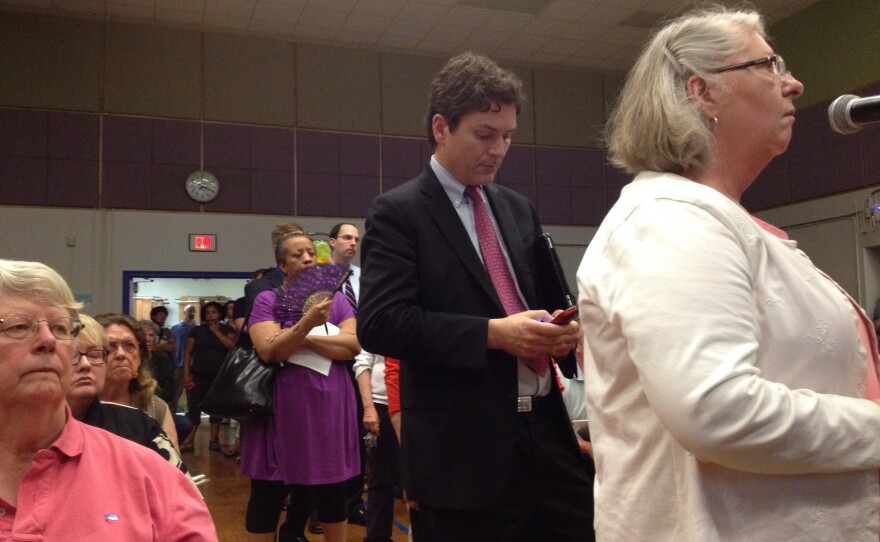For over ten years, the cleanup criterion for 1,4-Dioxane in Michigan has been 85 ppb. This is in spite of the fact that in 2010, the EPA in recommended 3.5 ppb as the screening level for a one in 100,000 cancer risk. Finally, the Michigan DEQ has proposed a safer limit: 7.2 ppb. Today—Earth Day—WEMU’s “The Green Room” looks a how this may affect Ann Arbor’s groundwater cleanup.
David Fair (DF): With water quality and public health on all of our minds, the conversation continues on how best to deal with a slowly spreading plume of 1, 4 dioxane in Ann Arbor-area groundwater. This week, Ann Arbor State Representative Jeff Irwin hosted a town hall meeting on the issue. Members of the Michigan Department of Environmental Quality attended to answer question about recently proposed, and more stringent, standards for dioxane. In this week’s edition of WEMU’s “The Green Room” we continue our series on the contamination plume, as Barbara Lucas tries to answer the question: “Will the new proposed dioxane standard make a difference?”
State Representative Jeff Irwin: Thank-you for coming.
Barbara Lucas (BL): Here’s Representative Jeff Irwin.
Irwin: …state DEQ director Keith Creagh to come tonight to talk to the community tonight about what this better cleanup standard means for hopefully a better cleanup here in Ann Arbor.
BL: After the presentations, a long line voiced questions.
Attendee 1: Does the change down to 7.2 mean any substantive change?
Attendee 2: What can we actually do to clean it rather than watch it go by?
Attendee 3: I have a tub of water in my basement, it’s not flooded, it’s just there. Is that dangerous?
Here’s Bob Wagner of the DEQ.
Robert Wagner: So that’s a great question. If you have sump pump and water in your basement and it has 1,4-Dioxane, 1,4-Dioxane has some ability to become a vapor. And when we talked about vapor intrusion, that could be a potential risk. So it’s really based upon what concentration that’s in your water that’s in your basement, either because of a sump pump or seeps or even flooding. So we’ll take a look at it.
BL: Dr. Larry Lemke is a geology professor at Wayne State University.
Larry Lemke: I get it that 85 is going to 7.2 because we’ve had an increase in the recognized toxicity of dioxane. Why then isn’t the groundwater-surface water interface also going down? That’s the one that’s really going to count here because everything that’s going on inside the Prohibition Zone is governed by that criterion.
Outdoor sounds, birds.
BL: I’m trying to get a grip on where the potential impacts will be. I’m in Dolph Park on Wagner Road. It’s in the Prohibition Zone which stretches east all the way to University Hospital, and contains Dioxane levels over 2,400 ppb. Because cleanup is not a goal in the Prohibition Zone, the DEQ’s proposed stricter cleanup standard won’t have an impact here.
Sounds of traffic.
BL: OK, now I’ve crossed to the west side of Wagner Road—out of the Prohibition Zone. This is the side of the plume where Gelman, Inc. is removing dioxane, by court order. Looking at plume maps, I still see sky high concentrations, over 3,000 ppb. How will a stricter standard affect things here? I call Dan Hamel of the DEQ.
BL: It’s really hard for me to grasp what the difference is going to be with 7.2. So you’ve got these places where it’s already above 85 ppb west of the prohibition zone, which it’s not supposed to be…
Dan Hamel: Yes.
BL: …but the court said ‘leave it there so long as it doesn’t migrate’
Hamel: ‘Expand’, right.
BL: So you potentially could expand the areas that are OK, until you reach 7.2?
Hamel: That wouldn’t be our intent. No, we don’t want to expand the area that is OK. We have no intention of saying ‘We are going to move it out.’ If anything, we are going to move it back.
BL: So levels above the safe standard, whether it’s 85 or 7.2 parts per billion, are allowed by the court order both inside and out of the Prohibition Zone. But at least a lower standard should help the DEQ in court. And there is one place near here where a level of 7.2 definitely would have made a difference.
Traffic sounds. Workers talking.
BL: In early March, workers installed city water to a household off Jackson Road, where for years a family with young children had been drinking well water with dioxane levels as high as 17 ppb. It was legal, because it was below Michigan’s 85 ppb limit.
BL: So a lower level is definitely a welcomed step in the right direction. How much of an impact it will make, and how soon, remains to be seen.
Traffic sounds fade.
BL: Barbara Lucas, 89 One, WEMU News
DF: 'The Green Room' will continue to add to the community conversation regarding the Ann Arbor area's 1,4 dioxane plume in the weeks and months to come. I'm David Fair and this is 89-1 WEMU.
RESOURCE
Video of April 18th Town Hall meeting
All Audio from the April 18th Town Hall Meeting provided courtesy of Michigan Radio.








